Climatic and Socioeconomic Aspects of Mushrooms: The Case of Spain
Abstract
1. Introduction
2. Materials and Methods
3. Results and Discussion
3.1. Climate as a Predictor of the Natural Fruiting of Macrofungi Carpophores
3.2. Phenology, Phenological Patterns and recent Trends in the Natural Production of Mushrooms, A Symptom of Climate Change?
3.3. Cultivation and Consumption of Fungi
3.4. Truffle-Farming and Future Potential for Peripheral Rural Areas
3.5. Multifunctional Management of the Mycological Landscape: Environmental Return from Wild Resources, Mycological Tourism and Mushroom-Related Silviculture
4. Conclusions
Author Contributions
Funding
Conflicts of Interest
References
- Tedersoo, L.; Bahram, M.; Põlme, S.; Kõljalg, U.; Yorou, N.S.; Wijesundera, R.; Ruiz, L.V.; Vasco-Palacios, A.M.; Thu, P.Q.; Suija, A.; et al. Global diversity and geography of soil fungi. Science 2014, 346, 1078–1088. [Google Scholar] [CrossRef] [PubMed]
- Kauserud, H.; Heegaard, E.; Büntgen, U.; Halvorsen, R.; Egli, S.; Senn-Irlet, B.; Krisai-Greilhuber, I.; Dämon, W.; Sparks, T.; Nordén, J.; et al. Warming-induced shift in European mushroom fruiting phenology. Proc. Natl. Acad. Sci. USA 2012, 109, 14488–14493. [Google Scholar] [CrossRef]
- Humphreys, C.P.; Franks, P.J.; Rees, M.; Bidartondo, M.I.; Leake, J.R.; Beerling, D.J. Mutualistic mycorrhiza-like symbiosis in the most ancient group of land plants. Nat. Commun. 2010, 1, 103. [Google Scholar] [CrossRef] [PubMed]
- Rayner, A.D.M.; Boddy, L. Fungal Decomposition of Wood: Its Biology and Ecology; Wiley-Interscience Publication: Chichester, UK, 1988. [Google Scholar]
- Ferris, R.; Peace, A.J.; Newton, A.C. Macrofungal communities of lowland Scots pine (Pinus sylvestris L.) and Norway spruce (Picea abies (L.) Karsten.) plantations in England: Relationships with site factors and stand structure. For. Ecol. Manag. 2000, 131, 255–267. [Google Scholar] [CrossRef]
- Ágreda, T.; Águeda, B.; Olano, J.M.; Vicente-Serrano, S.M.; Fernández-Toirán, M. Increase evapotranspiration demand in a Mediterranean climate might cause a decline in fungal yields under global warming. Glob. Chang. Biol. 2015, 21, 3499–3510. [Google Scholar] [CrossRef]
- Romano, N.; Lignola, G.P.; Brigante, M.; Bosso, L.; Chirico, G.B. Residual life and degradation assessment of wood elements used in soil bioengineering structures for slope protection. Ecol. Eng. 2016, 90, 498–509. [Google Scholar] [CrossRef]
- Asplund, J.; Kauserud, H.; Bokhorts, S.; Lie, M.H.; Ohlson, M.; Nybakken, L. Fungal communities influence decomposition rates of plant litter from two dominant tree species. Fungal. Ecol. 2018, 32, 1–8. [Google Scholar] [CrossRef]
- Hechmi, N.; Bosso, L.; El-Bassi, L.; Scelza, R.; Testa, A.; Jedidi, N.; Rao, M.A. Depletion of pentachlorophenol in soil microcosms with Byssochlamys nivea and Scopulariopsis brumptii as detoxification agents. Chemosphere 2016, 165, 547–554. [Google Scholar] [CrossRef]
- Esterhuizen-Londt, M.; Anna-Lena, H.; Stephan, P. Mycoremediation of diclofenac using Mucor hiemalis. Toxicol. Environ. Chem. 2017, 99, 795–808. [Google Scholar] [CrossRef]
- Pozdnyakova, N.N.; Balandina, S.A.; Dubrovskaya, E.V.; Golubev, C.N.; Turkovskaya, O.V. Ligninolytic basidiomycetes as promising organisms for the mycoremediation of PAH-contaminated Environments. IOP Conf. Ser. Earth. Environ. Sci. 2018, 107, 012071. [Google Scholar] [CrossRef]
- Igiehon, N.O.; Babalola, O.O. Fungal bio-sorption potential of chromium in Norkrans liquid medium by shake flask technique. J. Basic Microbiol. 2019, 59, 62–73. [Google Scholar] [CrossRef] [PubMed]
- Orwin, K.H.; Kirschbaum, M.; St. John, M.G.; Dickie, I.A. Organic nutrient uptake by mycorrhizal fungi enhances ecosystem carbon storage: A model-based assessment. Ecol. Lett. 2011, 14, 493–502. [Google Scholar] [CrossRef] [PubMed]
- Brundrett, M.C. Mycorrhizal associations and other means of nutrition of vascular plants: Understanding the global diversity of host plants by resolving conflicting information and developing reliable means of diagnosis. Plant Soil 2009, 320, 37–77. [Google Scholar] [CrossRef]
- Branzanti, M.B.; Rocca, E.; Piso, A. Effect of ectomycorrhizal fungi on chestnut ink disease. Mycorrhiza 1999, 9, 103–109. [Google Scholar] [CrossRef]
- Bosso, L.; Lacatena, F.; Varlese, R.; Nocerino, S.; Cristinzio, G.; Russo, D. Plant pathogens but not antagonists change in soil fungal communities across a land abandonment gradient in a Mediterranean landscape. Acta Oecol. 2017, 78, 1–6. [Google Scholar] [CrossRef]
- Rowan, D.D.; Popay, A.J. Endophytic fungi as mediators of plant-insect interactions. In Insect-Plant Interactions; CRC Press: Boca Raton, FL, USA, 1993; pp. 99–120. [Google Scholar]
- Vásquez-Gassibe, P.; Oria-de-Rueda, J.A.; Martín-Pinto, P. Pinus pinaster underextreme ecological conditions provides high fungal production and diversity. For. Ecol. Manag. 2015, 337, 161–173. [Google Scholar] [CrossRef]
- Boyer, L.R.; Brain, P.; Xu, X.M.; Jeffries, P. Inoculation of drought-stressed strawberry with a mixed inoculum of two arbuscular mycorrhizal fungi: Effects on population dynamics of fungal species in roots and consequential plant tolerance to water deficiency. Mycorrhiza 2015, 25, 215–227. [Google Scholar] [CrossRef]
- Hashem, A.; Abd-Allah, E.F.; Alqarawi, A.A.; Egamberdieva, D. Arbuscular Mycorrhizal Fungi and Plant Stress Tolerance. In Plant Microbiome: Stress Response; Egamberdieva, D., Ahmad, P., Eds.; Springer: Singapore, 2018; pp. 81–103. [Google Scholar]
- Baptista, P.; Martins, A.; Tavares, R.M.; Lino-Nieto, T. Diversity and fruiting pattern of macrofungi associated with chestnut (Castanea sativa) in the Trás-os-Montes region (Northeast Portugal). Fungal Ecol. 2010, 3, 9–19. [Google Scholar] [CrossRef]
- Martínez-Peña, F.; Agreda, T.; Agueda, B.; Ortega-Martinez, P.; Fernandez-Toiran, L.M. Edible sporocarp production by age class in a Scots pine stand in Northern Spain. Mycorrhiza 2012, 22, 167–174. [Google Scholar] [CrossRef]
- Dugan, F.M. Fungi in the Ancient World: How Mushrooms, Mildews, Molds, and Yeast Shaped the Early Civilizations of Europe, the Mediterranean, and the Near East; American Phytopathological Society: St. Paul, MN, USA, 2008. [Google Scholar]
- Yun, W.; Hall, I.R. Edible ectomycorrhizal mushrooms: Challenges and achievements. Can. J. Bot. 2004, 82, 1063–1073. [Google Scholar] [CrossRef]
- Maser, C.; Claridge, A.W.; Trappe, J.M. Trees, Truffles and Beasts? How Forest Function; Rutgers University Press: New Brunswick, NJ, USA, 2008. [Google Scholar]
- Ortega-Díaz, A. Setas de Andalucía Oriental; Colegio Oficial de Farmacéuticos de la Provincia de Granada: Granada, Spain, 1992. [Google Scholar]
- Martínez-de-Aragón, J. Productos forestales no madereros. Setas y hongos. In Evaluación de Recursos Forestales por CCAA; Beltrán, M., Vericat, P., Piqué, M., Eds.; Centro Tecnológico Forestal de Cataluña: Solsona, Spain, 2013; pp. 189–199. [Google Scholar]
- De-Frutos-Madrazo, P.; Martínez-Peña, F.; Esteban-Laleona, S. Edible wild mushroom tourism as a source of income and employment in rural areas. The case of Castilla y León. For. Syst. 2012, 21, 81–98. [Google Scholar] [CrossRef]
- Bonet, J.A.; González-Olabarria, J.R.; Martínez-de-Aragón, J. Mushroom production as an alternative for rural development in a forested mountainous area. J. Mt. Sci. 2014, 11. [Google Scholar] [CrossRef]
- Martínez-Ibarra, E.; Villar-Hernández, R. Aprovechamiento micológico y desarrollo rural. In XXV Congreso de la AGE. 50 años de Congresos de Geografía. Naturaleza, territorio y ciudad en un mundo global; Allende-Álvarez, F., Cañada-Torrecilla, R., Fernández-Mayoralas, G., Gómez-Mediavilla, G., López-Estébanez, N., Palacios-García, A., Rojo-Pérez, F., Vidal-Dominguez, M.J., Eds.; AGE: Madrid, Spain, 2017; pp. 270–278. [Google Scholar]
- Google Scholar (search). Available online: https://scholar.google.com/intl/en/scholar/help.html#searching (accessed on 31 December 2017).
- Boddy, L.; Büntgen, U.; Egli, S.; Gange, A.C.; Heegard, E.; Kirk, P.M.; Mohammad, A. Climate variation effects on fungal fruiting. Fungal Ecol. 2013, 10, 20–23. [Google Scholar] [CrossRef]
- Honrubia, M.; Morte, A.; Gutiérrez, A. Las terfezias. Un cultivo para el desarrollo rural en regiones áridas y semi-áridas. In Truficultura: Fundamentos y Técnicas; Reyna-Domenech, S., Ed.; Mundi-Prensa: Madrid, Spain, 2007; pp. 365–397. [Google Scholar]
- Reyna-Domenech, S.; García-Barreda, S. Black truffle cultivation: A global reality. For. Syst. 2014, 23, 317–328. [Google Scholar]
- Morcillo, M.; Sánchez, M.; Vilanova, X. Cultivar Trufas, una Realidad en Expansión; Micofora: Barcelona, Spain, 2015. [Google Scholar]
- Martínez-Peña, F.; Aldea, J.; de Frutos, P.; Campos, P. Renta ambiental de la recolección pública de setas silvestres en los sistemas forestales de Andalucía. In Biodiversidad, Usos del Agua Forestal y Recolección de Setas Silvestres en los Sistemas Forestales de Andalucía; Campo, P., Díaz, M., Eds.; Editoral CSIC: Madrid, Spain, 2015; pp. 274–388. [Google Scholar]
- Lázaro-García, A. El aprovechamiento micológico como vía de desarrollo rural en España: Las facetas comercial y recreativa. An. Geogr. 2008, 28, 111–136. [Google Scholar]
- Martínez-Garrido, E.; Sánchez-Urrea, J.; Torija-Santos, R. Turismo micológico y desarrollo sostenible del medio rural en Soria. In XII Coloquio de Geografía del Turismo, Ocio y Recreación; Fernández-Muñoz, S., Fidalgo-García, P., Gámir Orueta, A., García Álvarez, J., Manuel-Valdés, C., Marías-Martínez, D., Morales-Matos, G., Puente-Lozano, P., Trillo-Santamaría, J.M., Eds.; AGE: Madrid, Spain, 2010; pp. 335–351. [Google Scholar]
- Büntgen, U.; Latorre, J.; Egli, S.; Martínez Peña, F. Socio-economic, scientific, and political benefits of mycotourism. Ecosphere 2017, 8, e01870. [Google Scholar] [CrossRef]
- Índices CSIC (Documentos). Available online: https://indices.app.csic.es/bddoc-internet/pages/mtodocumentos/ConsultaDocumentos.html;jsessionid = 987F4CE7BFB153D7F8B052036C18925D?faces-redirect = true (accessed on 31 December 2018).
- Fundación Española para la Ciencia y la Tecnología (FECYT) (WOS advanced search). Available online: https://apps.webofknowledge.com/WOS_AdvancedSearch_input.do?SID = F5wMW1aoLgwkc7R42sv&product = WOS&search_mode = AdvancedSearch (accessed on 31 December 2018).
- FAOSTAT. Available online: http://www.fao.org/faostat/en/#data (accessed on 2 March 2017).
- INEBASE. Available online: http://www.ine.es/inebmenu/indice.htm (accessed on 2 March 2017).
- Hjalager, A.M. A typology of gastronomy tourism. In Gastronomy and Tourism; Hjalager, A.M., Richards, G., Eds.; Routledg: New York, NY, USA, 2012; pp. 21–35. [Google Scholar]
- Büntgen, U.; Peter, M.; Kauserud, H.; Egli, S. Unraveling environmental drivers of a recent increase in Swiss fungi fruiting. Glob. Chang. Biol. 2013, 19, 2785–2794. [Google Scholar] [CrossRef] [PubMed]
- Hall, I.R.; Wang, Y.; Amicucci, A. Cultivation of edible ectomycorrhizal mushrooms. Trends Biotechnol. 2003, 21, 433–438. [Google Scholar] [CrossRef]
- Bonet, J.A.; Palahí, M.; Colinas, C.; Pukkala, T.; Fischer, C.R.; Miina, J.; Martínez-de-Aragón, J. Modelling the production and species richness of wild mushrooms in pine forests of the Central Pyrenees in northeastern Spain. Can. J. For. Res. 2010, 40, 347–356. [Google Scholar] [CrossRef]
- Bonet, J.A.; de Miguel, S.; Martínez-de-Aragón, J.; Pukkala, T.; Palahí, M. Inmediate effect of thinning on the yield of Lactarius group deliciosus in Pinus pinaster forests in Northeastern Spain. For. Ecol. Manag. 2012, 265, 211–217. [Google Scholar] [CrossRef]
- Büntgen, U.; Egli, S.; Camarero, J.; Fischer, E.M.; Stobbe, U.; Kauserud, H.; Tegel, W.; Sproll, L.; Stenseth, N.C. Drought-induced decline in Mediterranean truffle harvest. Nat. Clim. Chang. 2012, 2, 827–829. [Google Scholar] [CrossRef]
- Le Tacon, F.; Marçcais, B.; Courvoisier, M.; Murat, C.; Montpied, P.; Becker, M. Climatic variations explain annual fluctuations in French Périgord black truffle wholesale markets but do not explain the decrease in black truffle production over the last 48 years. Mycorrhiza 2014, 24, 115–125. [Google Scholar] [CrossRef] [PubMed]
- Laganà, A.; Angiolini, C.; Loppi, S.; Salerni, E.; Perini, C.; Barluzzi, C.; de Dominics, V. Periodicity, fluctuations and successions of macrofungi in fir forests (Abies alba Miller) in Tuscany, Italy. For. Ecol. Manag. 2002, 169, 187–202. [Google Scholar] [CrossRef]
- Krebs, C.J.; Carrier, P.; Boutin, S.; Boonstra, R.; Hofer, E. Mushroom crops in relation to weather in the southwestern Yukon. Botany 2008, 86, 1497–1502. [Google Scholar] [CrossRef]
- Kauserud, H.; Heegard, E.; Semenov, M.A.; Boddy, L.; Halvorsen, R.; Stige, L.C.; Sparks, T.H.; Gange, A.C.; Stenseth, N.C. Climate change and spring-fruiting fungi. Proc. R. Soc. B Biol. Sci. Biol. 2010, 277, 1169–1177. [Google Scholar] [CrossRef] [PubMed]
- Eveling, D.W.; Wilson, R.N.; Gillespie, E.S.; Bataille, A. Environmental effects on sporocarp counts over fourteen years in a foresta area. Mycol. Res. 1990, 94, 998–1002. [Google Scholar] [CrossRef]
- Lindahl, B.D.; Ihrmark, K.; Boberg, J.; Trumbore, S.E.; Högberg, P.; Stenlid, J.; Finlay, R.D. Spatial separation of litter decomposition and mycorrhizal nitrogenuptake in a boreal forest. New Phytol. 2007, 173, 611–620. [Google Scholar] [CrossRef] [PubMed]
- Büntgen, U.; Tegel, W.; Egli, S.; Stobbe, U.; Sproll, L.; Stenseth, N.C. Truffles and climate change. Front. Ecol. Environ. 2011, 9, 150–151. [Google Scholar] [CrossRef]
- Sato, H.; Morimoto, S.; Hattori, T.A. Thirty-Year Survey Reveals That Ecosystem Function of Fungi Predicts Phenology of Mushroom Fruiting. PLoS ONE 2012, 7, e49777. [Google Scholar] [CrossRef]
- Kottek, M.; Grieser, J.; Beck, C.; Rudolf, B.; Rubel, F. World Map of the Köppen-Geiger climate classification updated. Meteorol. Z. 2006, 15, 259–263. [Google Scholar] [CrossRef]
- Mello, A.; Murat, C.; Bonfante, P. Truffles: Much more than a prized and local fungal decay. FEMS Microbiol. Lett. 2006, 260, 1–8. [Google Scholar] [CrossRef] [PubMed]
- De la Varga, H.; Águeda, B.; Ágreda, T.; Martínez-Peña, F.; Parladé, J.; Pera, J. Seasonal dynamics of Boletus edulis and Lactarius deliciosus extraradical mycelium in pine forests of central Spain. Mycorrhiza 2013. [Google Scholar] [CrossRef] [PubMed]
- Gange, A.C.; Gange, E.G.; Sparks, T.H.; Boddy, L. Rapid and Recent Changes in Fungal Fruiting Patterns. Science 2007, 316, 71. [Google Scholar] [CrossRef] [PubMed]
- Rosenzweig, C.; Casassa, G. Assessment of observed changes and responses in natural and managed systems. In Climate Change 2007: Impacts, Adaptation and Vulnerability. Contribution of Working Group II to the Fourth Assessment Report of the Intergovernmental Panel on Climate Change; Parry, M.L., Canziani, F., Palutikof, J.P., van der Linden, P.J., Hanson, C.E., Eds.; Cambridge University Press: Cambridge, UK, 2007; pp. 79–131. [Google Scholar]
- Mohammad, A.B. Spatial and Temporal Aspects of Macrofungal Community Structure; Royal Holloway University of London: London, UK, 2013. [Google Scholar]
- Callot, G. La truffe, la Terre, la Vie; Editions Quae: Paris, France, 1999. [Google Scholar]
- Diez, J.M.; James, T.Y.; McMunn, M.; Ibáñez, I. Predicting species-specific responses of fungi to climatic variation using historical records. Glob. Chang. Biol. 2013. [Google Scholar] [CrossRef] [PubMed]
- Gange, A.C.; Gange, E.G.; Mohammad, A.B.; Boddy, L. Host shifts in fungi caused by climate change? Fungal Ecol. 2011, 4, 184–190. [Google Scholar] [CrossRef]
- Gange, A.C.; Mohammad, A.B.; Damialis, A.; Gange, E.G. Mushroom phenological changes: A role for resource availability? Proc. Natl. Acad. Sci. USA 2013, 110, E333–E334. [Google Scholar] [CrossRef] [PubMed]
- Wakchaure, G.C. Production and Marketing of mushrooms: Global and national scenario. In Mushrooms-Cultivation, Marketing and Consumption; Singh, M., Vijay, B., Kamal, S., Wakchaure, G.C., Eds.; Directorate of Mushroom Research: Solan, Indai, 2011; pp. 15–22. [Google Scholar]
- Larumbe, E. Estrategias push and pull de marketing en el sector de setas y champiñones. In Propiedades saludables del consumo de champiñón; Asociación Española de Cultivadores del Champiñon: Logroño, Spain, 2007; pp. 63–78. [Google Scholar]
- Roncero-Ramos, I. Propiedades nutricionales y saludables de los hongos. Available online: http://www.adenyd.es/wp-content/uploads/2015/02/Informe-sobre champi%C3%B1%C3%B3n-y-setas.pdf (accessed on 8 March 2017).
- Martínez-Peña, F.; Oria-de-Ruefa, J.A.; Ágreda, T. Manual para la gestión del recurso micológico forestal en Castilla y León; SOMACYL-Junta: Castilla, Spain, 2011; Available online: http://www.micosylva.com/manual/files/manual_simp.pdf (accessed on 1 January 2018).
- Altares, G. 8.600 habitantes, 36.000 kilos de trufa. El País. 2015. Available online: http://politica.elpais.com/politica/2015/02/27/actualidad/1425060271_757109.html (accessed on 2 April 2017).
- MAGRAMA. Resultados técnico-económicos de Cultivos Herbáceaos 2010; Ministerio de Agricultura, Alimentación y Medio Ambiente: Madrid, Spain, 2013. Available online: https://www.mapa.gob.es/es/ministerio/servicios/analisis-y prospectiva/Herb%C3%A1ceos%202010_tcm30-88513.pdf (accessed on 1 January 2018).
- MAGRAMA. Resultados técnico-económicos de Cultivos Herbáceos 2011; Ministerio de Agricultura, Alimentación y Medio Ambiente: Madrid, Spain, 2013. Available online: https://www.mapa.gob.es/es/ministerio/servicios/analisis-y-prospectiva/Herb%C3%A1ceos%202011_tcm30-88510.pdf (accessed on 1 January 2018).
- MAGRAMA. Resultados técnico-económicos de Cultivos Herbáceos 2012; Ministerio de Agricultura, Alimentación y Medio Ambiente: Madrid, Spain, 2014. Available online: https://www.mapa.gob.es/es/ministerio/servicios/analisis-y-prospectiva/Herb%C3%A1ceos%202012_tcm30-88507.pdf (accessed on 1 January 2018).
- MAGRAMA. Resultados técnico-económicos de Cultivos Herbáceos 2013; Ministerio de Agricultura, Alimentación y Medio Ambiente: Madrid, Spain, 2014. Available online: https://es.scribd.com/document/372569753/Herbaceos-2013-tcm7-359284 (accessed on 1 January 2018).
- MAGRAMA. Resultados técnico-económicos de Cultivos Herbáceos 2014; Ministerio de Agricultura, Alimentación y Medio Ambiente: Madrid, Spain, 2015. Available online: https://www.mapa.gob.es/es/ministerio/servicios/analisis-y-prospectiva/herbaceos2014_tcm30-88500.pdf (accessed on 1 January 2018).
- MAGRAMA. Resultados técnico-económicos de Cultivos Hortícolas 2010; Ministerio de Agricultura, Alimentación y Medio Ambiente: Madrid, Spain, 2013. Available online: https://www.mapa.gob.es/es/ministerio/servicios/analisis-y-prospectiva/Hort%C3%ADcolas.2010_tcm30-88515.pdf (accessed on 1 January 2018).
- MAGRAMA. Resultados técnico-económicos de Cultivos Hortícolas 2011; Ministerio de Agricultura, Alimentación y Medio Ambiente: Madrid, Spain, 2013. Available online: https://www.mapa.gob.es/es/ministerio/servicios/analisis-y-prospectiva/Hort%C3%ADcolas.2011_tcm30-88512.pdf (accessed on 1 January 2018).
- MAGRAMA. Resultados técnico-económicos de Cultivos Hortícolas 2012; Ministerio de Agricultura, Alimentación y Medio Ambiente: Madrid, Spain, 2014. Available online: https://www.mapa.gob.es/es/ministerio/servicios/analisis-y-prospectiva/Hort%C3%ADcolas.2012_tcm30-88509.pdf (accessed on 1 January 2018).
- MAGRAMA. Resultados técnico-económicos de Cultivos Hortícolas 2013; Ministerio de Agricultura, Alimentación y Medio Ambiente: Madrid, Spain, 2014. Available online: https://www.mapa.gob.es/es/ministerio/servicios/analisis-y-prospectiva/Hort%C3%ADcolas.2013_tcm30-88506.pdf (accessed on 1 January 2018).
- MAGRAMA. Resultados técnico-económicos de Cultivos Hortícolas 2014; Ministerio de Agricultura, Alimentación y Medio Ambiente: Madrid, Spain, 2015. Available online: https://www.mapa.gob.es/es/ministerio/servicios/analisis-y-prospectiva/horticolas2014_tcm30-88501.pdf (accessed on 1 January 2018).
- MAGRAMA. Resultados técnico-económicos de Cultivos Leñosos 2010; Ministerio de Agricultura, Alimentación y Medio Ambiente: Madrid, Spain, 2012. Available online: https://www.mapa.gob.es/es/ministerio/servicios/analisis-y-prospectiva/Le%C3%B1osos%202010_tcm30-88514.pdf (accessed on 1 January 2018).
- MAGRAMA. Resultados técnico-económicos de Cultivos Leñosos 2011; Ministerio de Agricultura, Alimentación y Medio Ambiente: Madrid, Spain, 2013. Available online: https://www.mapa.gob.es/es/ministerio/servicios/analisis-y-prospectiva/Le%C3%B1osos%202011_tcm30-88511.pdf (accessed on 1 January 2018).
- MAGRAMA. Resultados técnico-económicos de Cultivos Leñosos 2012; Ministerio de Agricultura, Alimentación y Medio Ambiente: Madrid, Spain, 2014.
- MAGRAMA. Resultados técnico-económicos de Cultivos Leñosos 2013; Ministerio de Agricultura, Alimentación y Medio Ambiente: Madrid, Spain, 2014. Available online: https://www.mapa.gob.es/es/ministerio/servicios/analisis-y-prospectiva/Le%C3%B1osos%202013.._tcm30-88505.pdf (accessed on 1 January 2018).
- MAGRAMA. Resultados técnico-económicos de Cultivos de Frutales 2014; Ministerio de Agricultura, Alimentación y Medio Ambiente: Madrid, Spain, 2015. Available online: https://www.mapa.gob.es/es/ministerio/servicios/analisis-y-prospectiva/frutales_tcm30-88502.pdf (accessed on 1 January 2018).
- MAGRAMA. Resultados técnico-económicos de Cultivos de Olivar y Viñedo 2014; Ministerio de Agricultura, Alimentación y Medio Ambiente: Madrid, Spain, 2015. Available online: https://www.mapa.gob.es/es/ministerio/servicios/analisis-y-prospectiva/olivaryvinedo2014_tcm30-88503.pdf (accessed on 1 January 2018).
- Danell, E.; Alexander, S.J.; Colinas, C. Aportación de la truficultura al desarrollo socioeconómico. Vida Rural. 2003, 181, 54–60. [Google Scholar]
- Morte, A.; Zamora, M.; Gutiérrez, A.; Honrubia, M. Desert truffle cultivation in semiarid Mediterranean areas. In Mycorrhizas: Functional Processes and Ecological Impact; Gianinazzi-Pearson, V., Azcón, C., Eds.; Springer: Heidelberg, Germany, 2009; pp. 221–233. [Google Scholar]
- Morte, A.; Andrino, A. Domestication: Preparation of Mycorrhizal Seedlings. In Desert Truffles. Phylogeny, Physiology, Distribution and Domestication; Kagan-Zur, V., Roth-Bejerano, N., Sitrit, Y., Morte, A., Eds.; Springer: Berlin, Germany, 2014; pp. 343–365. [Google Scholar]
- Honrubia, M.; Andrino, A.; Morte, A. Preparation and Maintenance of Both Man-Planted and Wild Plots. In Desert Truffles. Phylogeny, Physiology, Distribution and Domestication; Kagan Zur, V., Roth Bejerano, N., Sitrit, Y., Morte, A., Eds.; Springer: Berlin, Germany, 2014; pp. 367–387. [Google Scholar]
- Oria-de-Rueda, J.A.; Garcia, C.; Martin, P.; Martinez, A.; Olaizola, J.; de la Parra, B.; Fraile, R.; Alvarez, M.A. Hongos y Setas. Tesoro de Nuestros Montes; Ediciones Cálamo: Palencia, Spain, 2007. [Google Scholar]
- MAGRAMA. Anuario de Estadística Forestal; Ministerio de Agricultura, Alimentación y Medio Ambiente: Madrid, Spain, 2011.
- Boletín Oficial del Estado. Real Decreto 30/2009, de 16 de Enero, por el que se Establecen las Condiciones Sanitarias para la Comercialización de Setas para uso Alimentario; Ministerio de la Presidencia Español: Madrid, Spain, 2009.
- Moreni, B.; Gómez, J.; Jiménez, F.; Infante, F. Setas de Andaucía. Con Especial Referencia a sus Parques Naurales; Centro Andaluz del Libro: Sevilla, Spain, 1996. [Google Scholar]
- Sánchez Rodriguez, J.A. Los hongos: Manual y guía didáctica de micología; Instituto de Restauración y Medio Ambiente: León, Spain, 2004. [Google Scholar]
- Esteve Reventós, F.; Ortega Díaz, A.; Llistosella Vidal, J. Setas de la Peninsula Ibérica e Islas Baleares; Ediciones Jagüar: Madrid, Spain, 2007. [Google Scholar]
- Moreno, G.; Majón, J.L. Guía de Hongos de la Peninsula Ibérica; Ediciones Omega: Barcelona, Spain, 2010. [Google Scholar]
- Honrubia, M.; Figueroa, V.; Fajardo, J.; Verde, A.; Etxarri, X. Guía de Hongos Micodes; Grupo de Desarrollo Rural Altiplano de Granada: Baza, Spain, 2013. [Google Scholar]
- Ceres. Consulta Sobre Aspectes Relacionats Amb la Recollida de Bolets en el Marc de l’omnibus Catalunya; Ceres: Barcelona, Spain, 2008. [Google Scholar]
- Reyna-Domenech, S. Sostenibilidad de la truficultura: Aspectos ecológicos, económicos y sociales. In Truficultura: Fundamentos y Técnicas; Reyna Domenech, S., Ed.; Mundi-Prensa: Madrid, Spain, 2007; pp. 51–73. [Google Scholar]
- García Ferrando, M.; Llopis Goig, R. Encuesta Sobre los Hábitos Deportivos en España 2010. Ideal Democrático y Bienestar Personal; Universidad de Valencia: Valencia, Spain, 2011. [Google Scholar]
- Picardo, A. El proyecto MYAS-RC de Castilla y León: Resultados generales y del programa de coordinación. In Proceedings of the Simposio Internacional de Gestión Forestal del Recurso Micológico, Valladolid, Spain, 9–11 June 2011; Available online: http://www.micosylva.com/content/balance-del-plan-cussta-en-andalucia (accessed on 1 January 2018).
- MICOVALDORBA. Available online: https://www.valdorba.org/micovaldorba2/pagina.shtml (accessed on 1 January 2018).
- Moreno-Arroyo, B. Plan Cussta. In Proceedings of the Simposio Internacional de Gestión Forestal del Recurso Micológico, Valladolid, Spain, 9–11 June 2011; Available online: http://www.micosylva.com/content/balance-del-plan-cussta-en-andalucia (accessed on 1 January 2018).
- MICODES. Available online: http://sierradelsegura.com/proyectos/micodes/ (accessed on 1 January 2018).
- Oria-de-Rueda, J.A.; de la Parra, B.; Olaizola, J.; Martin, P.; Martinez de Azagra, A.; Alvarez, A. Selvicultura micológica. In Compendio de Selvicultura Aplicada; Serrada, R., Gregorio, M., Reque, J.A., Eds.; Instituto Nacional de Tecnologia Agraria y Alimentaria: Madrid, Spain, 2008. [Google Scholar]
- Boletín Oficial del Estado. Ley 43/2003, de 21 de noviembre, de Montes; Jefatura del Estado: Madrid, Spain, 2003. [Google Scholar]
- Boletín Oficial de Castilla y León. DECRETO 31/2017, de 5 de octubre, por el que se regula el Recurso Micológico Silvestre en Castilla y León; Consejería de Economía y Hacienda: Valladolid, Spain, 2017. [Google Scholar]
- Boletín Oficial de la Junta de Andalucía. Resolución de 7 de septiembre de 2017, de la Delegación Territorial de Medio Ambiente y Ordenación del Territorio en Almería, sobre recogida de hongos en los terrenos forestales de la provincia; Junta de Andalucía: Sevilla, Spain, 2017.
- Boletín Oficial de la Junta de Andalucía. Resolución de 1 de octubre de 2018, de la Delegación Territorial de Medio Ambiente y Ordenación del Territorio en Jaén, sobre recogida de hongos en los terrenos forestales de la provincia; Junta de Andalucía: Sevilla, Spain, 2018.
- Aldea, J.; Martínez-Peña, F.; Romero, C.; Diaz-Balteiro, L. Participatory goal programming in forest management: An application integrating several ecosystem services. Forests 2014, 5, 3352–3371. [Google Scholar] [CrossRef]
- Martínez Peña, F.; García, R. Ordenación del recurso micológico en la comarca de Pinares de Soria-Burgos. In Proceedings of the Actas del XII Congreso Forestal Mundial, Quebec, QC, Canada, 21–28 September 2003; pp. 319–320. [Google Scholar]
- Aldea, J.; Martínez-Peña, F.; Díaz-Balteiro, L. Integration of fungal production in forest management using a multi-criteria method. Eur. J. For. Res. 2012, 131, 1991–2003. [Google Scholar] [CrossRef]
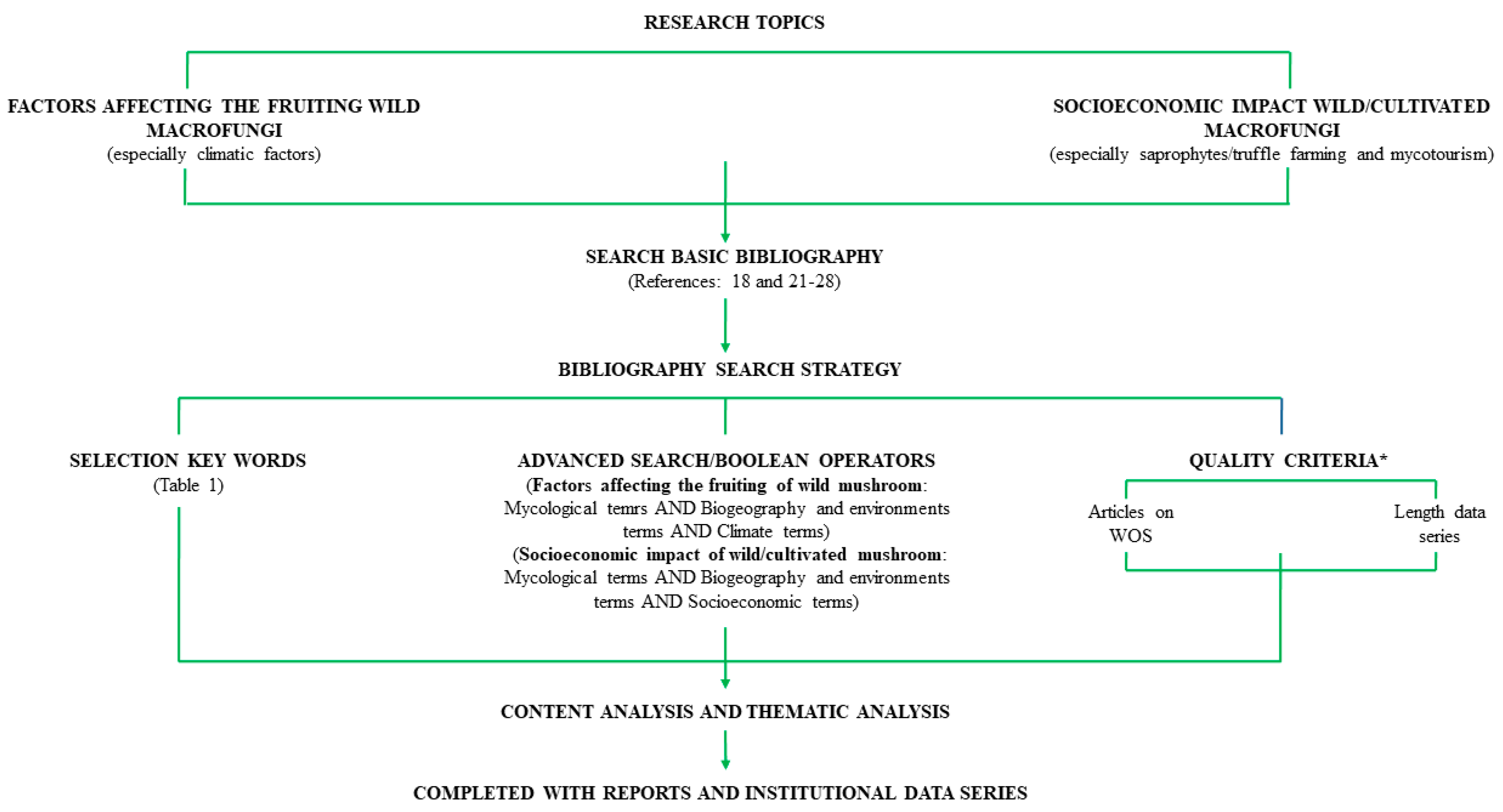
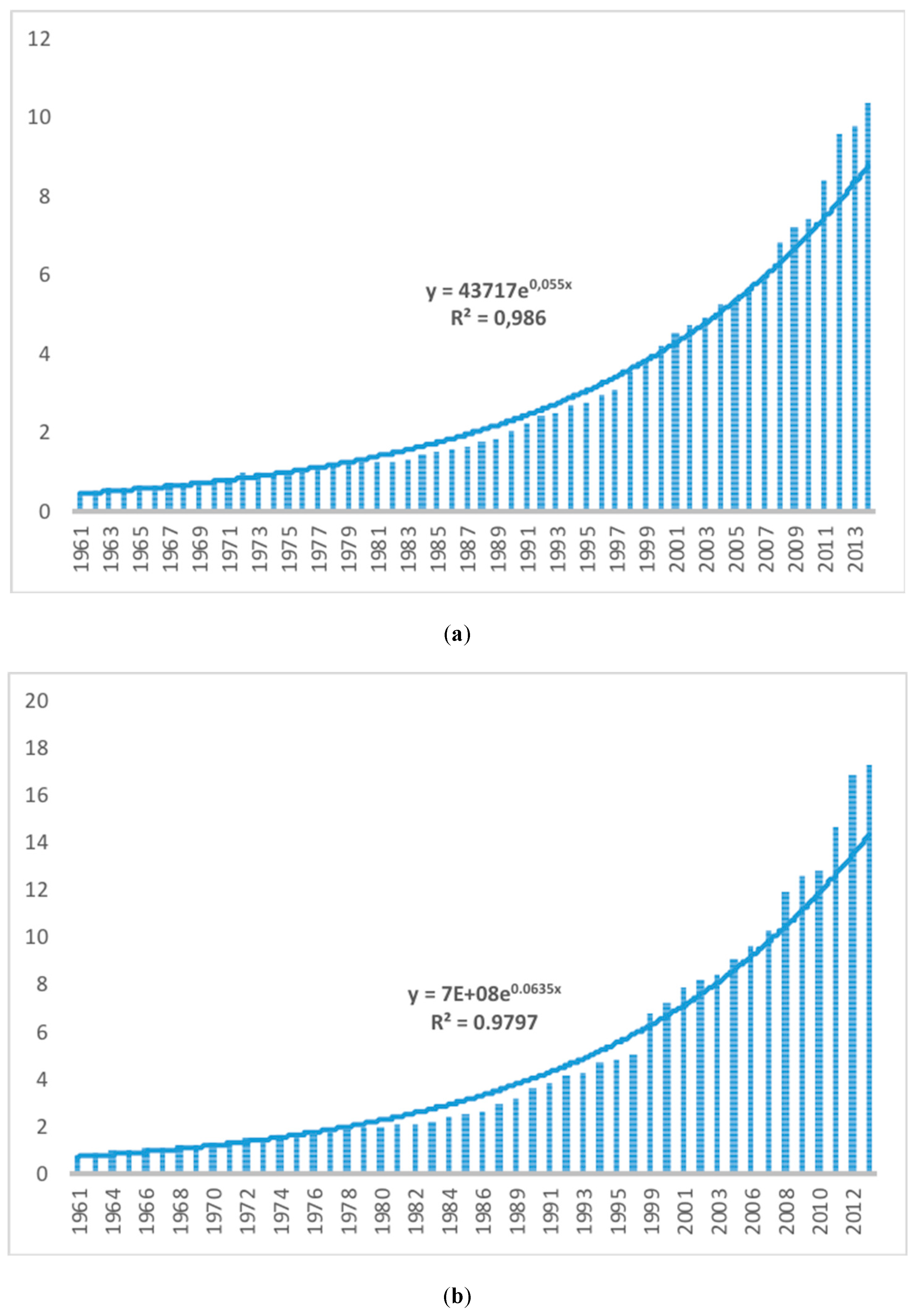
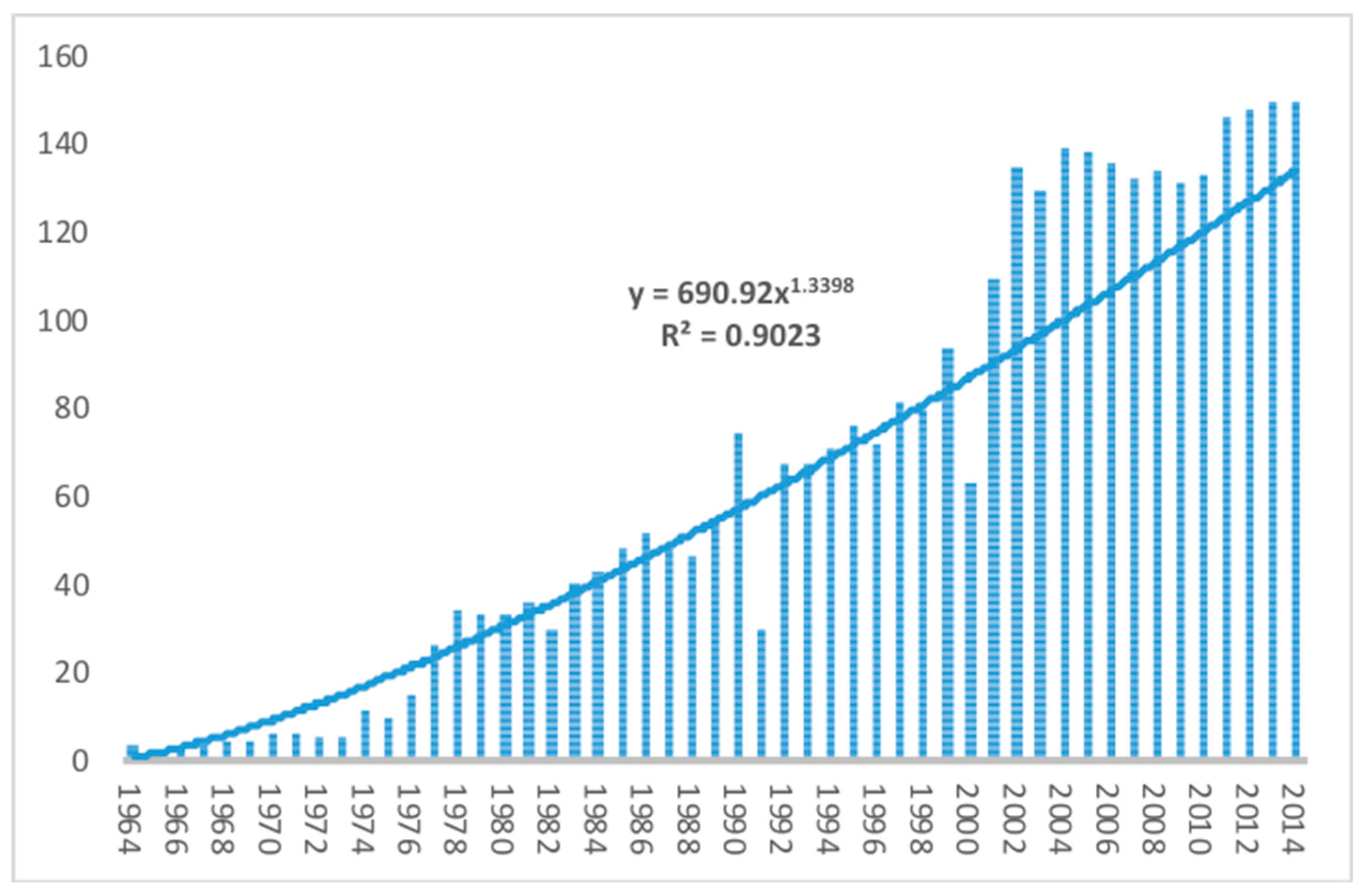
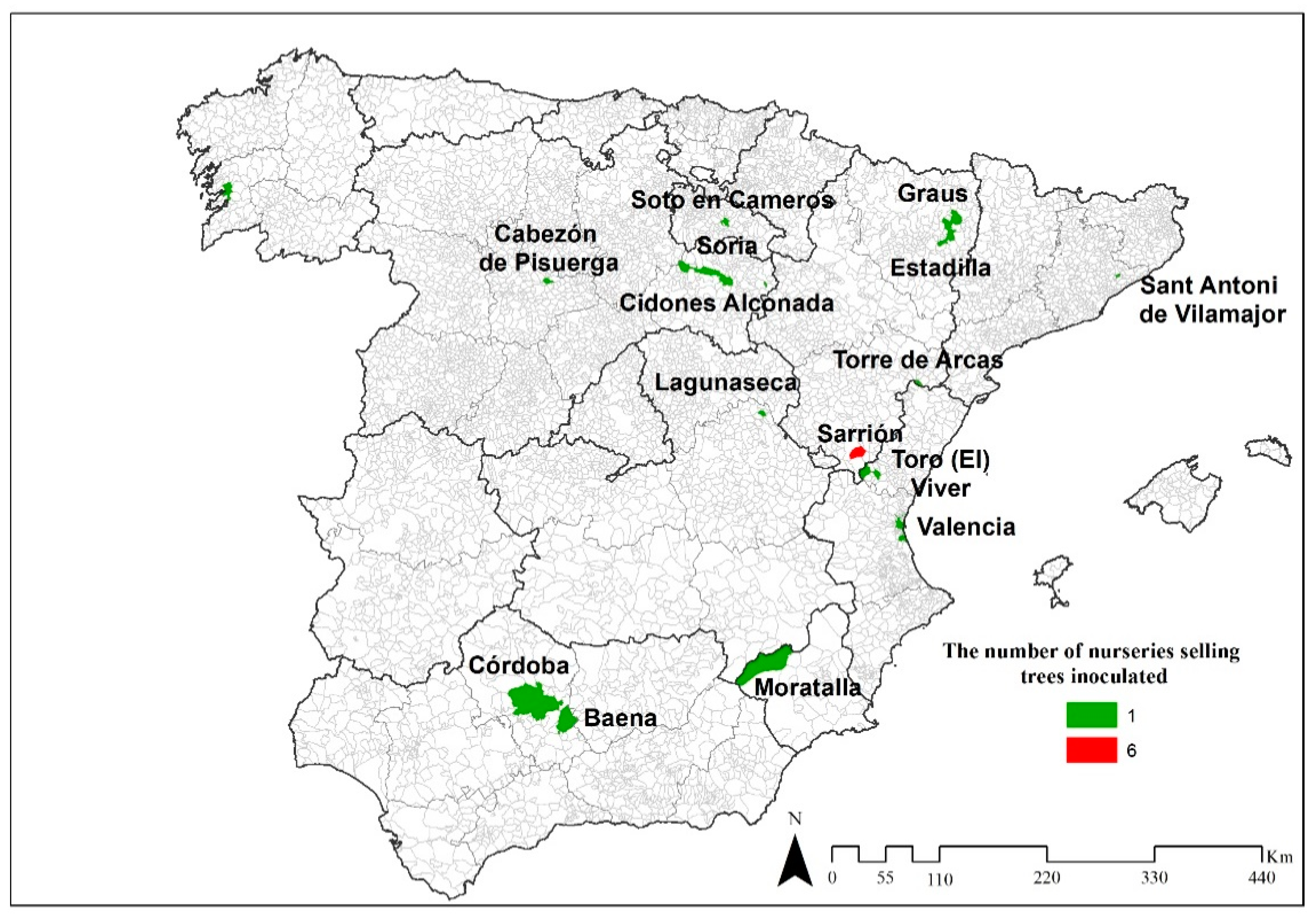
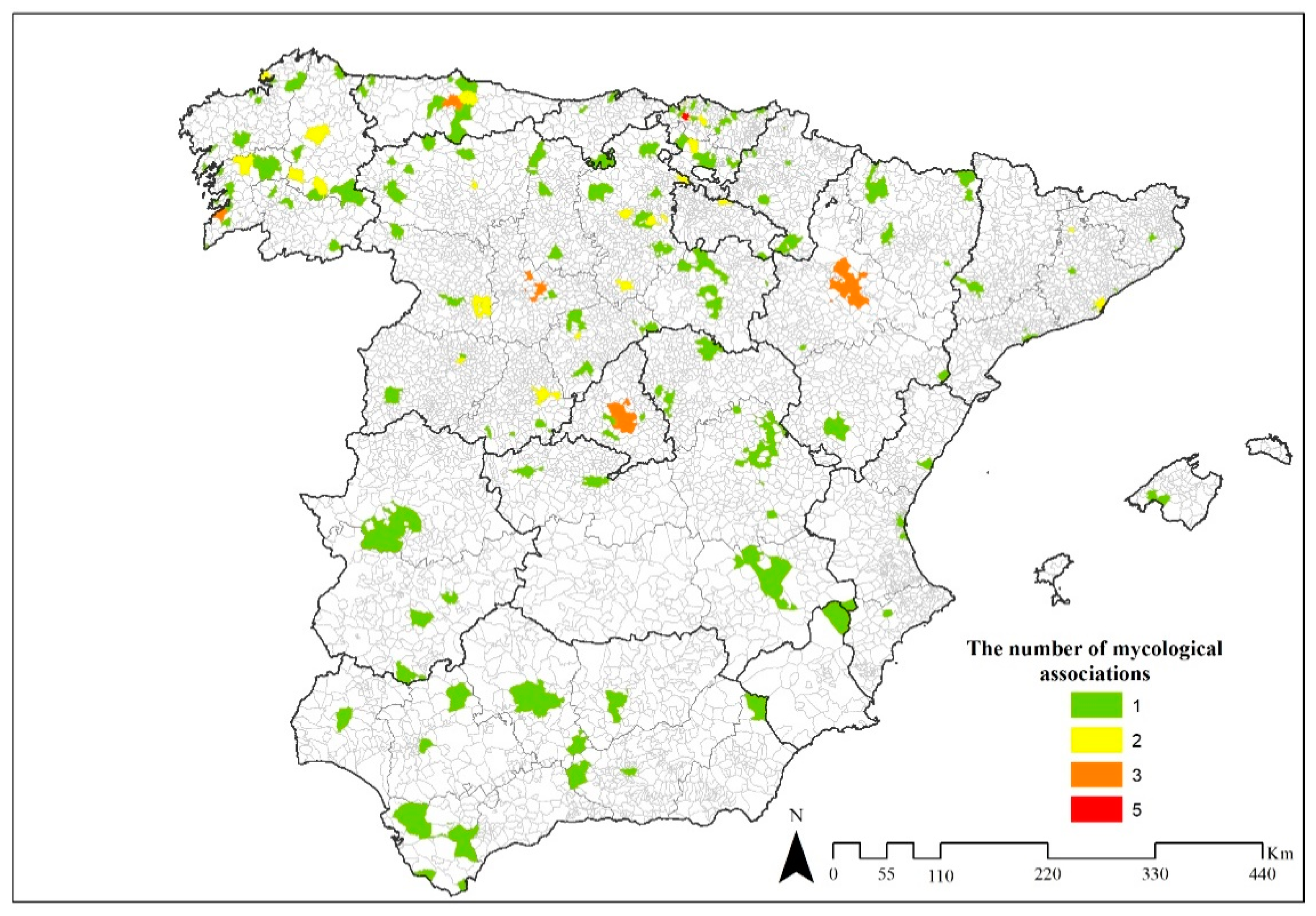
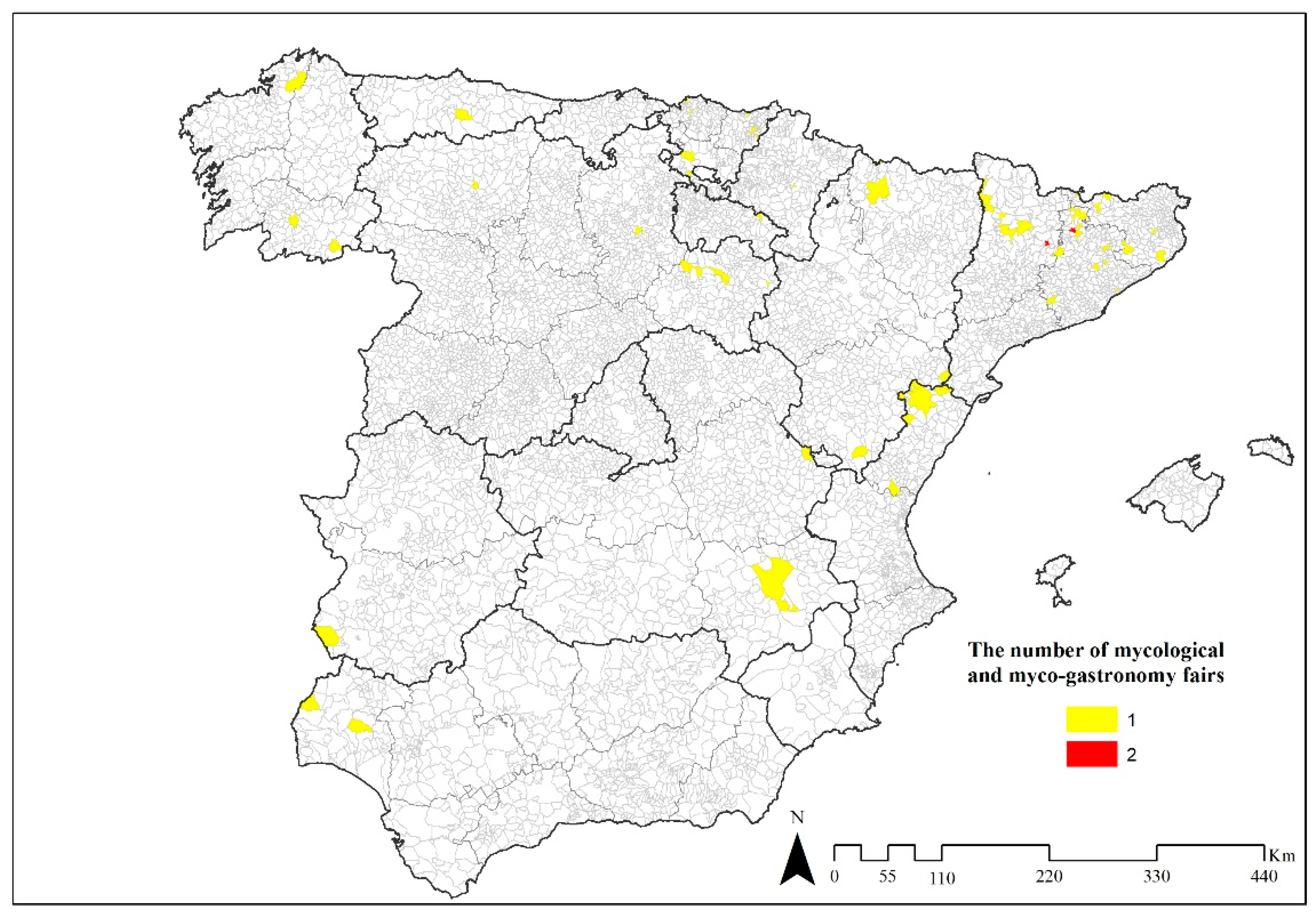
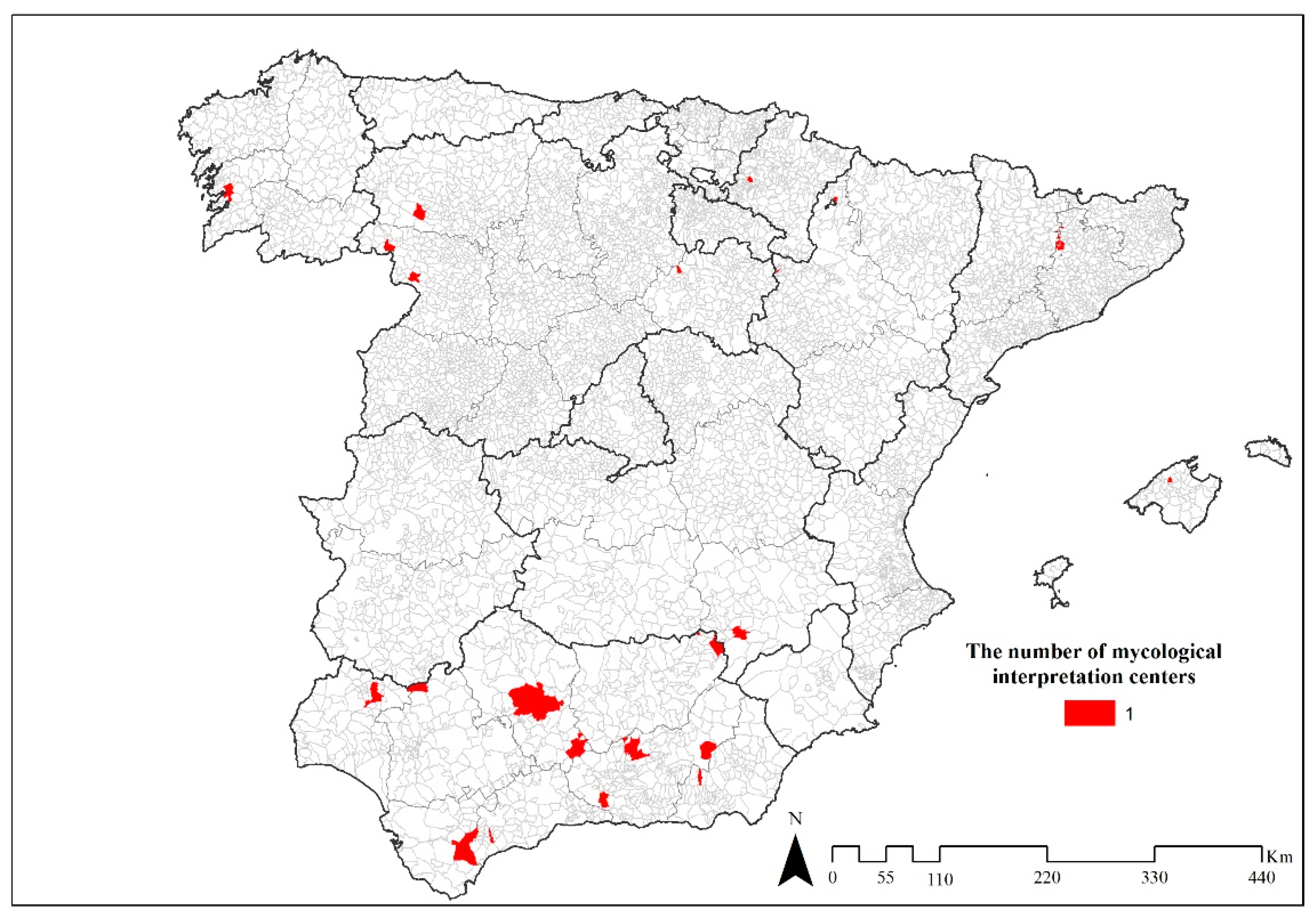
| Mycological Terms | Sporocarp; Fungi; Macrofungi; Macromycetes; Mycelium; Mycoflora; Mycorrhizas; Mushrooms; Truffle; Tuber |
|---|---|
| Biogeography and Environment Terms | Thinning of forest; biogeography; time changes (in fruiting patterns); forest cover; chorology; fruiting bodies; diversity; age of the forest; endemicity; seasonality; environmental factors; phenology; fruiting patterns; habitats; hygrophilous; distribution models; niche; pending; production; sporocarps; thermophilic; geographical variation; xerophyte |
| Climate Terms | Global warming; climate; climate change; weather; evapotranspiration; precipitation; drought; temperature; meteorological variables; Hydric Balance |
| Socioeconomic Terms | Economic profit; economic contribution; development; rural development; employment; gastronomy; forest management; socioeconomic impact; income; mycotourism; multifunctionality of forests; price; non-wood forest products; mushroom picking; truffle picking; edible mushrooms; silviculture; tourism; mycological tourism; economic value; economic variables; sales |
| Geographical Data | Mycological Data | Main Results | References |
|---|---|---|---|
| SW Yukon, Canada Climate: Dfc | EF (annual), 15 years ECM and SAP | Biomass r May P (tyear-1) = +0.75 r June P (to) = +0.68 | [52] |
| Chanéaz, Switzerland Climate: Cfb/Dfb | EF (annual), 36 years ECM | Carpophores (number) r annual T (to) = +0.92 (12-annual moving average) | [56] |
| Chanéaz, Switzerland Climate: Cfb/Dfb | EF (annual), 36 years ECM and SAP | Carpophores (number) r April and August T (to) = +0.72 r ∑ P (to) = +0.5 | [45] |
| Higashiyama, Japan Climate: Cfa | EF (annual), 30 years ECM and SAP | Carpophores (number) r monthly T (to) ≈+0.5 r ∑ P (to) ≈+0.5 | [57] |
| Soria, Spain Climate: Csb (2) | EF (autumn), 15 years ECM and SAP | Biomass r ∑ P (t≥10 days) = +0.64 | [6] |
| Pyrenees, Spain Climate: Cfb/Csb | EF (autumn), 13 years ECM and SAP | Biomass r ∑ August–November P (to) = +0.86 | [47] |
| Mediterranean, Europe Climate: Cfa/b-Csa/b | HF (winter), 37 years ECM Tuber melanosporum | Biomass r ∑ July–August P (tyear-1) = +0.6 r means July–August T (tyear-1) = −0.57 | [49] |
| South of France Climate: Csa (2) | HF (winter), 24 years ECM Tuber melanosporum Tuber brumale (5%) | Sales from two main markets r ∑ May-August HB (tyear-1) = +0.61 and + 0.68 (depending on the market) | [50] |
| Geographical Data | Mycological Data | Most Important Results | References |
|---|---|---|---|
| Norway and the United Kingdom Climate: ET, Df, Cfb | EF (spring), 48 years ECM and SAP (mainly) | Carpophores (number) 1.Phenological changes:tart of season has moved forward (3.8 days/decade) | [53] |
| Norway, the United Kingdom, Austria and Switzerland Climate: ET, Df, Cfb | EF (autumn), 38 years ECM and SAP | Carpophores (number) 1. Phenological changes: Lengthening of the season (start delayed and finish delayed) with differences between species and countries | [2] |
| Michigan, USA Climate: Dfa/b | EF (annual), 101 years ECM and SAP | Carpophores (number) 1. Phenological changes: Start delayed (0.18 days/decade) with differences between functional groups and host types (deciduous vs evergreen) 2. Production trends ( = ) | [65] |
| Chanéaz, Switzerland Climate: Cfb/Dfb | EF (annual), 36 years ECM and SAP | Carpophores (number) 1. Phenology: peak of production (September-October) 2. Phenological changes: Start delayed (13 days from 1975 to 2006) with differences between functional groups and host types (deciduous vs evergreen) 3. Positive production trends in both ECM and SAP | [45] |
| Chanéaz, Switzerland Climate: Cfb/Dfb | EF (annual), 36 years ECM | Carpophores (number) 1. Phenology: peak of production (September-October) 2. Phenological changes: delayed peak production (1975–1990/1991–2006: 10 days) and lengthening of season 3. Positive production trends(1975–1990/1991–2006: number of carpophores per week from 42 to 88) | [57] |
| Salisbury, United Kingdom Climate: Cfb | EF (autumn), 56 years ECM and SAP | Carpophores (number) 1. Phenological changes: lengthening of season: from 33.2 ±1.6 days in 1950 to 74.8 ± 7.6 days in 2005 (start brought forward and end delayed) | [66,67] |
| Higashiyama, Japan Climate: Cfa | EF (annual), 30 years ECM and SAP | Carpophores (number) 1. Phenology: ECM unimodal pattern: peak production (July); small decomposers bimodal pattern: production peaks (early summer and early autumn) 2. Positive production trends only wood decomposer fungi (due to aging of the forest) | [58] |
| Soria, Spain Climate: Csb (2) | EF (autumn), 15 years ECM and SAP | Carpophores (number) and Biomass 1. Phenology: start 40.4 ± 0.6 weeks, end 47.5 ± 0.5 weeks), duration (7.1 ± 0.7 weeks) | [6] |
| Type | Rain-fed | Irrigated | Source | |
|---|---|---|---|---|
| Herbaceous crops | Corn | 2340 | [73,74,75,76] | |
| barley | 510 | 781 | ||
| wheat | 589 | 948 | ||
| sunflowers | 323 | |||
| dried peas | 267 | |||
| Vegetables | peppers (greenhouse) | 54,723 | [77,78,79,80,81,82] | |
| watermelons | 10,408 | |||
| tomatoes (greenhouse) | 53,136 | |||
| melons | 6441 | |||
| Fruit | oranges | 4384 | [83,84,85,86,87,88] | |
| peaches | 7623 | |||
| olives (Mill) | 905 | 2040 | ||
| plums | 9138 | |||
| nectarines | 9327 | |||
| almonds | 699 | |||
| Truffle farming | Tuber melanosporum | 5400 | ||
| 19,424–66,972 | [35] | |||
| 12,000 | Production [89] and prices [35] | |||
| Terfezia claveryi | 1028 | Production* [90] and price of 5 euros/kg | ||
| Product | Economic Value in Thousands of Euros | % of Total Economic Value |
|---|---|---|
| Logging | 721,416 (Value in the loading bay in 2009) | 72.7 |
| Firewood | 23,775 (Value in 2009) | 2.4 |
| Cork | 51,242 | 5.7 |
| Resin | 4157 | 0.4 |
| Esparto | 2 | 0.0 |
| Chestnuts | 1200 | 0.1 |
| Truffles | 1293 | 0.1 |
| Other fungi | 108,350 | 10.9 |
| Other fruit, plants and products | 7443 | 0.8 |
| Hunting and fishing | 73,228.21 | 7.4 |
| Total | 992,106 | 100 |
© 2019 by the authors. Licensee MDPI, Basel, Switzerland. This article is an open access article distributed under the terms and conditions of the Creative Commons Attribution (CC BY) license (http://creativecommons.org/licenses/by/4.0/).
Share and Cite
Martínez-Ibarra, E.; Gómez-Martín, M.B.; Armesto-López, X.A. Climatic and Socioeconomic Aspects of Mushrooms: The Case of Spain. Sustainability 2019, 11, 1030. https://doi.org/10.3390/su11041030
Martínez-Ibarra E, Gómez-Martín MB, Armesto-López XA. Climatic and Socioeconomic Aspects of Mushrooms: The Case of Spain. Sustainability. 2019; 11(4):1030. https://doi.org/10.3390/su11041030
Chicago/Turabian StyleMartínez-Ibarra, Emilio, María Belén Gómez-Martín, and Xosé Anton Armesto-López. 2019. "Climatic and Socioeconomic Aspects of Mushrooms: The Case of Spain" Sustainability 11, no. 4: 1030. https://doi.org/10.3390/su11041030
APA StyleMartínez-Ibarra, E., Gómez-Martín, M. B., & Armesto-López, X. A. (2019). Climatic and Socioeconomic Aspects of Mushrooms: The Case of Spain. Sustainability, 11(4), 1030. https://doi.org/10.3390/su11041030







